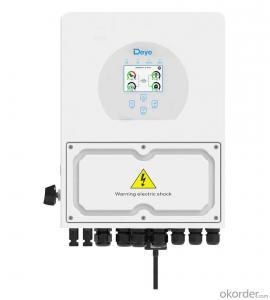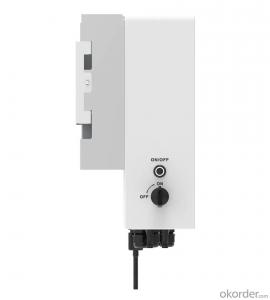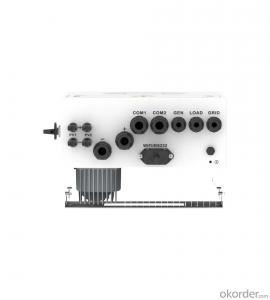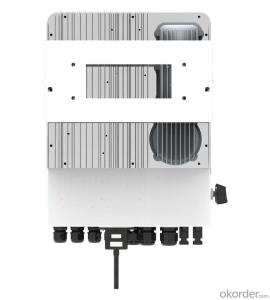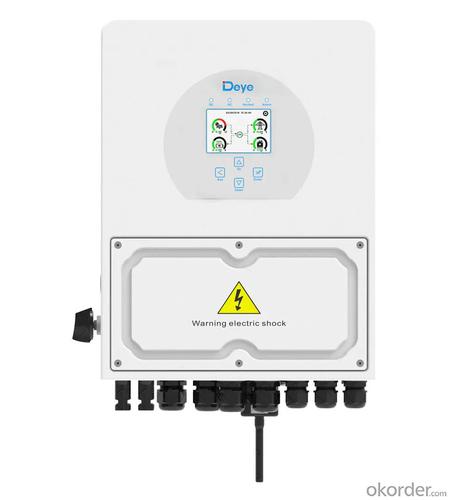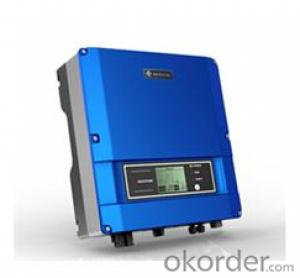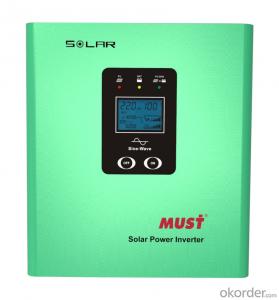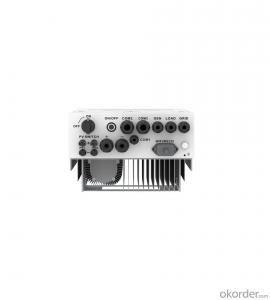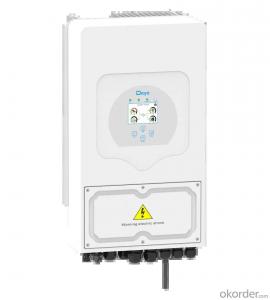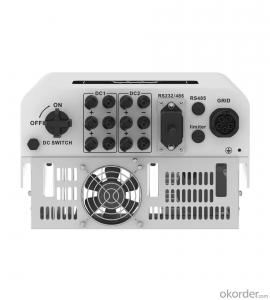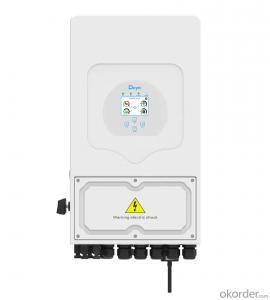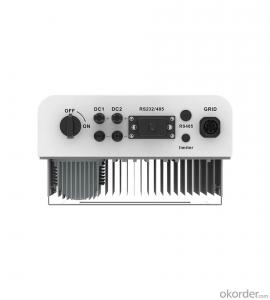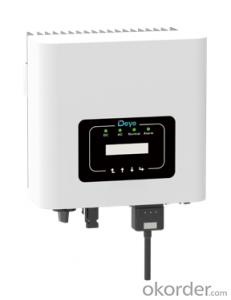15kVA Solar Inverter - Sun-3/3.6/5/6k-SG04LP1 | 3-6kW | Single Phase | 2 MPPT | Hybrid Inverter | Low Voltage Battery
- Loading Port:
- Ningbo
- Payment Terms:
- TT OR LC
- Min Order Qty:
- 100 pc
- Supply Capability:
- 5000 pc/month
OKorder Service Pledge
OKorder Financial Service
You Might Also Like
Specification
| Technical Data | |||||||
| Model | SUN-3K -SG04LP1-24-EU | SUN-3K -SG04LP1-EU | SUN-3.6K -SG04LP1-EU | SUN-5K -SG04LP1-EU | SUN-6K -SG04LP1-EU | ||
| Battery Input Data | |||||||
| Battery Type | Lead-acid or Li-lon | ||||||
| Battery Voltage Range (V) | 20~30 | 40~60 | 40~60 | 40~60 | 40~60 | ||
| Max. Charging Current (A) | 140 | 70 | 90 | 120 | 135 | ||
| Max. Discharging Current (A) | 140 | 70 | 90 | 120 | 135 | ||
| Number of battery input | Yes | ||||||
| Charging Curve | 3 Stages / Equalization | ||||||
| Charging Strategy for Li-Ion Battery | Self-adaption to BMS | ||||||
| PV String Input Data | |||||||
| Max. DC Input Power (W) | 3900 | 3900 | 4680 | 6500 | 7800 | ||
| Rated PV Input Voltage (V) | 370 (125~500) | ||||||
| Start-up Voltage (V) | 125 | ||||||
| MPPT Voltage Range (V) | 150-425 | ||||||
| Full Load DC Voltage Range (V) | 300-425 | ||||||
| PV Input Current (A) | 13 | 13+13 | |||||
| Max. PV ISC (A) | 17 | 17+17 | |||||
| No.of MPP Trackers | 1 | 2 | |||||
| No.of Strings per MPP Tracker | 1 | ||||||
| AC Output Data | |||||||
| Rated AC Output and UPS Power (W) | 3000 | 3600 | 5000 | 6000 | |||
| Max. AC Output Power (W) | 3300 | 3690 | 5500 | 6600 | |||
| AC Output Rated Current (A) | 13.6/13 | 16.4/15.7 | 22.7/21.7 | 27.3/26.1 | |||
| Max. AC Current (A) | 15/14.3 | 18/17.2 | 25/23.9 | 30/28.7 | |||
| Max. Continuous AC Passthrough (A) | 35 | 40 | |||||
| Peak Power (off grid) | 2 time of rated power, 10 S | ||||||
| Power Factor | 0.8 leading to 0.8 lagging | ||||||
| Output Frequency and Voltage | 50/60Hz; L/N/PE 220/230Vac (single phase) | ||||||
| Grid Type | Single Phase | ||||||
| DC injection current (mA) | THD<3% (Linear load<1.5%) | ||||||
| Efficiency | |||||||
| Max. Efficiency | 0.976 | ||||||
| Euro Efficiency | 0.965 | ||||||
| MPPT Efficiency | 0.999 | ||||||
| Protection | |||||||
| Integrated | PV Input Lightning Protection, Anti-islanding Protection, PV String Input Reverse Polarity Protection, Insulation Resistor Detection, Residual Current Monitoring Unit, Output Over Current Protection, Output Shorted Protection, Surge protection | ||||||
| Output Over Voltage Protection | DC Type II/AC Type III | ||||||
| Certifications and Standards | |||||||
| Grid Regulation | CEI 0-21, VDE-AR-N 4105, NRS 097, IEC 62116, IEC 61727, G99, G98, VDE 0126-1-1, RD 1699, C10-11 | ||||||
| Safety EMC / Standard | IEC/EN 61000-6-1/2/3/4, IEC/EN 62109-1, IEC/EN 62109-2 | ||||||
| General Data | |||||||
| Operating Temperature Range (℃) | -40~60℃, >45℃ derating | ||||||
| Cooling | Natural cooling | ||||||
| Noise (dB) | <30 dB | ||||||
| Communication with BMS | RS485; CAN | ||||||
| Size (mm) | 330W x 433H x238D IP65 | ||||||
| Protection Degree | IP65 | ||||||
| Installation Style | Wall-mounted | ||||||
| Warranty | 5 years | ||||||
| Weight (kg) | 14 | 15.1 | |||||
Colorful touch LCD, IP65 protection degree
6 time periods for battery charging/discharging
Max. charging/discharging current of 120A
Max.16pcs parallel
DC couple and AC couple to retrofit existing solar system
Support storing energy from diesel generator
24/48V low voltage battery, safe and reliable
Unique Smart Load application and Grid peak shaving function
4ms fast transfer from on-grid to off-grid mode, ensuing the traditional fixed frequency air conditioner works well
SUN 3/6K-SG04,hybrid inverter, is suitable for residential and light commercial use, maximizing self-consumption rate of solar energy and increasing your energy impendence. During the day, the PV system generates electricity which will be provided to the loads initially. Then, the excess energy will charge the battery via SUN 3/6K-SG04. Finally, the stored energy can be released when the loads require it. The battery can also be charged by the diesel generator to ensure uninterrupted supply in the event of grid blackout.
It equipped with RS485/CAN port for battery communication.
- Q: Can a solar inverter be integrated with smart home systems?
- Yes, a solar inverter can be integrated with smart home systems. Smart home systems are designed to connect and control various devices in the home, including solar inverters. By integrating a solar inverter with a smart home system, homeowners can monitor and control their solar energy production, consumption, and storage, as well as optimize energy usage based on real-time data. This integration allows for greater efficiency, convenience, and cost savings in managing solar power within a smart home ecosystem.
- Q: How does a solar inverter convert DC power to AC power?
- A solar inverter converts DC power to AC power by utilizing a two-step process. First, it converts the DC power generated by the solar panels into a high-frequency AC current. Then, it uses a transformer to increase the voltage and shape the AC waveform to match the grid's requirements. This process allows the solar energy to be fed into the electrical grid or used directly in homes and businesses.
- Q: How does a solar inverter handle variations in solar irradiation?
- A solar inverter handles variations in solar irradiation by continuously monitoring the incoming solar energy and adjusting its output accordingly. It uses maximum power point tracking (MPPT) technology to ensure that it extracts the maximum power available from the solar panels under different irradiation levels. This allows the inverter to regulate the voltage and current output to match the varying solar conditions, ensuring optimal efficiency and power conversion.
- Q: What is maximum power point tracking (MPPT) in a solar inverter?
- Maximum Power Point Tracking (MPPT) in a solar inverter is a technique used to optimize the energy output of a solar panel system by continuously tracking and adjusting the operating point of the panels to ensure they are operating at their maximum power point. This is achieved by dynamically adjusting the voltage and current levels to match the changing environmental conditions and load requirements, allowing the solar panels to produce the maximum amount of power available at any given time.
- Q: Photovoltaic grid-connected inverter problem
- But Baidu Encyclopedia clearly pointed out: the zero line is the secondary side of the transformer leads the neutral point of the line, and the phase line constitutes a circuit for power supply equipment.
- Q: What is the importance of voltage and frequency control in a solar inverter?
- The importance of voltage and frequency control in a solar inverter is crucial for maintaining the stability and reliability of the power output. By regulating the voltage and frequency levels, the inverter ensures that the electricity generated from the solar panels is in sync with the grid requirements. This control is necessary to prevent damage to electrical appliances and equipment, maintain grid stability, and enable seamless integration of solar energy into the existing power system.
- Q: Can a solar inverter be connected to a battery backup system?
- Yes, a solar inverter can be connected to a battery backup system. In fact, this connection is essential for storing excess solar energy generated during the day and using it during times when the sun is not shining, such as at night or during power outages. The battery backup system allows for uninterrupted power supply and greater energy independence.
- Q: Can a solar inverter be used in a remote location without access to the grid?
- No, a solar inverter cannot be used in a remote location without access to the grid. Solar inverters convert DC power generated by solar panels into AC power, which is suitable for use in homes and businesses connected to the electrical grid. Without access to the grid, there is no way to utilize the output of a solar inverter.
- Q: Can a solar inverter be used in locations with high humidity or extreme temperatures?
- Yes, solar inverters are designed to withstand high humidity and extreme temperatures. They are built with robust materials and protective coatings to ensure reliable operation in various environmental conditions. Additionally, many solar inverters undergo extensive testing and are certified to meet industry standards for performance and durability in challenging climates.
- Q: Can a solar inverter be used in a solar water pumping system?
- Yes, a solar inverter can be used in a solar water pumping system. The solar inverter is responsible for converting the direct current (DC) power generated by the solar panels into alternating current (AC) power, which is suitable for powering the water pump. This allows the solar water pumping system to operate efficiently and effectively, utilizing the solar energy to pump water without the need for grid electricity.
Send your message to us
15kVA Solar Inverter - Sun-3/3.6/5/6k-SG04LP1 | 3-6kW | Single Phase | 2 MPPT | Hybrid Inverter | Low Voltage Battery
- Loading Port:
- Ningbo
- Payment Terms:
- TT OR LC
- Min Order Qty:
- 100 pc
- Supply Capability:
- 5000 pc/month
OKorder Service Pledge
OKorder Financial Service
Similar products
Hot products
Hot Searches
Related keywords
